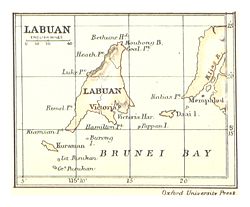
Back مستعمره تاج لابوآن Persian Labuanin kruununsiirtomaa Finnish Colonie de la Couronne de Labuan French Koloni Labuan ID Colonia di Labuan Italian ラブアン直轄植民地 Japanese Jajahan Mahkota Labuan Malay Thuộc địa vương thất Labuan Vietnamese 纳闽直辖殖民地 Chinese
Crown Colony of Labuan Pulau Labuan | |||||||||||||||||||
|---|---|---|---|---|---|---|---|---|---|---|---|---|---|---|---|---|---|---|---|
| 1848–1946 | |||||||||||||||||||
| Anthem: God Save the Queen (1848–1901) God Save the King (1901–1946) | |||||||||||||||||||
 Map of Labuan, 1888 | |||||||||||||||||||
| Status | British colony | ||||||||||||||||||
| Capital | Victoria | ||||||||||||||||||
| Common languages | English, Malay and Chinese etc. | ||||||||||||||||||
| Monarch | |||||||||||||||||||
• 1848–1890 | Queen Victoria (first) | ||||||||||||||||||
• 1936–1946 | George VI (last) | ||||||||||||||||||
| Governor | |||||||||||||||||||
• 1848–1852 | James Brooke (first) | ||||||||||||||||||
• 1945–1946 | Shenton Thomas (last) | ||||||||||||||||||
| Historical era | British Empire | ||||||||||||||||||
• Establishment of the crown colony | 1848 | ||||||||||||||||||
• Transferred to North Borneo | 1890 | ||||||||||||||||||
• British government rule | 1904 | ||||||||||||||||||
• Incorporated into Straits Settlements | 1 January 1907 | ||||||||||||||||||
| 3 January 1942 | |||||||||||||||||||
| 10 June 1945 | |||||||||||||||||||
• Labuan to North Borneo Crown | 15 July 1946 | ||||||||||||||||||
| Population | |||||||||||||||||||
• 1864[1] | 2,000 | ||||||||||||||||||
• 1890[2] | 5,853 | ||||||||||||||||||
• 1911[3] | 6,545 | ||||||||||||||||||
• 1941[4] | 8,963 | ||||||||||||||||||
| Currency | North Borneo dollar (1890–1907) Straits dollar (1907–1939) Malayan dollar (1939–1946) | ||||||||||||||||||
| |||||||||||||||||||
| Today part of | Malaysia ∟ Labuan | ||||||||||||||||||
The Crown Colony of Labuan was a Crown colony off the northwestern shore of the island of Borneo established in 1848 after the acquisition of the island of Labuan from the Sultanate of Brunei in 1846. Apart from the main island, Labuan consists of six smaller islands; Burung, Daat, Kuraman, Papan, Rusukan Kecil, and Rusukan Besar.
Labuan was expected by the British to be a second Singapore, but it did not fulfill its promise especially after the failure of its coal production that did not become fruitful, causing investors to withdraw their money, leaving all machinery equipment and Chinese workers that had entered the colony previously. The Chinese workers then began involving themselves in other businesses with many becoming chief traders of the island's produce of edible bird's nest, pearl, sago and camphor, with the main successful production later being the coconut, rubber and sago.
World War II brought the invasion of Japanese forces which abruptly ended British administration. Subsequently, Labuan became the place where the Japanese commander in Borneo surrendered to the Allied forces, with the territory placed under a military administration before merging into the Crown Colony of North Borneo.
- ^ Geography of British Colonies 1864, p. 31.
- ^ Hong Kong Daily Press Office 1904, p. 792.
- ^ Hong Kong Daily Press Office 1912, p. 1510.
- ^ Steinberg 2016, p. 225.

